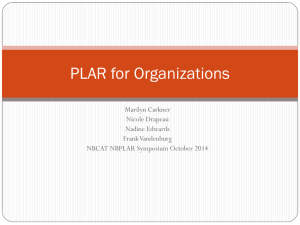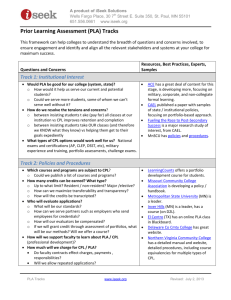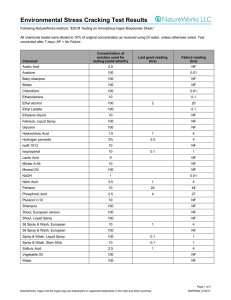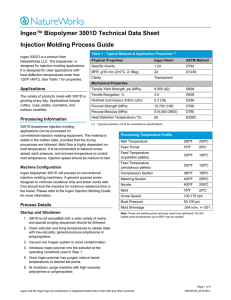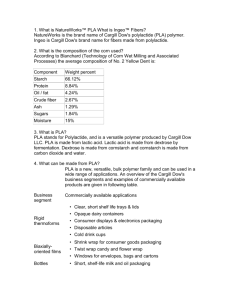PLA Filament Texturing Process Guide
advertisement
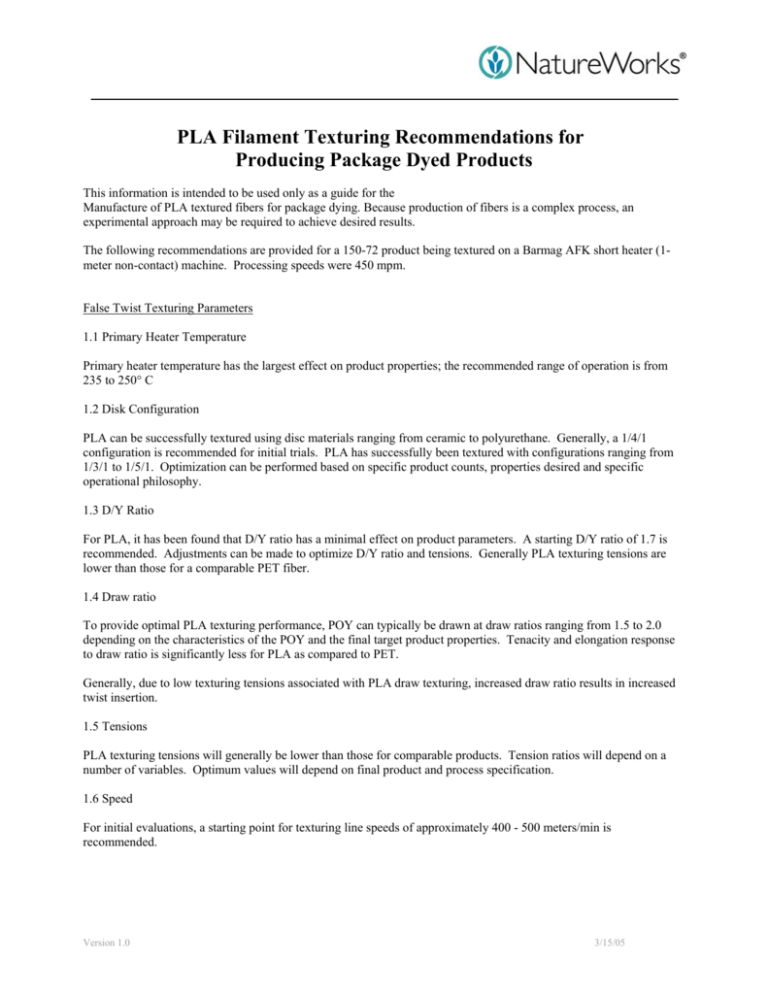
PLA Filament Texturing Recommendations for Producing Package Dyed Products This information is intended to be used only as a guide for the Manufacture of PLA textured fibers for package dying. Because production of fibers is a complex process, an experimental approach may be required to achieve desired results. The following recommendations are provided for a 150-72 product being textured on a Barmag AFK short heater (1meter non-contact) machine. Processing speeds were 450 mpm. False Twist Texturing Parameters 1.1 Primary Heater Temperature Primary heater temperature has the largest effect on product properties; the recommended range of operation is from 235 to 250° C 1.2 Disk Configuration PLA can be successfully textured using disc materials ranging from ceramic to polyurethane. Generally, a 1/4/1 configuration is recommended for initial trials. PLA has successfully been textured with configurations ranging from 1/3/1 to 1/5/1. Optimization can be performed based on specific product counts, properties desired and specific operational philosophy. 1.3 D/Y Ratio For PLA, it has been found that D/Y ratio has a minimal effect on product parameters. A starting D/Y ratio of 1.7 is recommended. Adjustments can be made to optimize D/Y ratio and tensions. Generally PLA texturing tensions are lower than those for a comparable PET fiber. 1.4 Draw ratio To provide optimal PLA texturing performance, POY can typically be drawn at draw ratios ranging from 1.5 to 2.0 depending on the characteristics of the POY and the final target product properties. Tenacity and elongation response to draw ratio is significantly less for PLA as compared to PET. Generally, due to low texturing tensions associated with PLA draw texturing, increased draw ratio results in increased twist insertion. 1.5 Tensions PLA texturing tensions will generally be lower than those for comparable products. Tension ratios will depend on a number of variables. Optimum values will depend on final product and process specification. 1.6 Speed For initial evaluations, a starting point for texturing line speeds of approximately 400 - 500 meters/min is recommended. Version 1.0 3/15/05 1.7 Secondary Heat The use of secondary heat is not required to produce a low shrinkage and high bulk yarn when sufficiently high primary heater temperatures are used. Recommended Conditions and product properties for Package Dye Applications run on Barmag AFK 1m non-contact heater POY Primary Heater 260(150)-72 250 250 Secondary Heater Draw Ratio D/Y Ratio Disk Config Speed off Safety and Handling Considerations Material Safety Data (MSD) sheets for PLA polymers are available from NatureWorks LLC. MSD sheets are provided to help customers satisfy their own handling, safety, and disposal needs, and those that may be required by locally applicable health and safety regulations, such as OSHA (U.S.A.), MAK (Germany), or WHMIS (Canada). MSD sheets are updated regularly; therefore, please request and review the most current MSD sheets before handling or using any product. The following comments apply only to PLA polymers; additives and processing aids used in fabrication and other materials used in finishing steps have their own safe-use profile and must be investigated separately. Hazards and Handling Precautions PLA polymers have a very low degree of toxicity and, under normal conditions of use, should pose no unusual problems from incidental ingestion, or eye and skin contact. However, caution is advised when handling, storing, using, or disposing of these resins, and good housekeeping and controlling of dusts are necessary for safe handling of product. Workers should be protected from the possibility of contact with molten resin during fabrication. Handling and fabrication of resins can result in the generation of vapors and dusts that may cause irritation to eyes and the upper respiratory tract. In dusty atmospheres, use an approved dust respirator. Pellets or beads may present a slipping hazard. Good general ventilation of the polymer processing area is recommended. At temperatures exceeding the polymer melt temperature (typically 170ºC), polymer can release fumes, which may contain fragments of the polymer, creating a potential to irritate eyes and mucous membranes. Good general ventilation should be sufficient 1.675 1.7 1/4/1 PU Winder Overfeed Tenacity g/den Elong % 10% 2.5 30.00 450 for most conditions. Local exhaust ventilation is recommended for melt operations. Use safety glasses if there is a potential for exposure to particles which could cause mechanical injury to the eye. If vapor exposure causes eye discomfort, use a full-face respirator. No other precautions other than clean, body-covering clothing should be needed for handling PLA polymers. Use gloves with insulation for thermal protection when exposure to the melt is localized. Combustibility PLA polymers will burn. Clear to white smoke is produced when product burns. Toxic fumes are released under conditions of incomplete combustion. Do not permit dust to accumulate. Dust layers can be ignited by spontaneous combustion or other ignition sources. When suspended in air, dust can pose an explosion hazard. Firefighters should wear positive-pressure, self-contained breathing apparatuses and full protective equipment. Water or water fog is the preferred extinguishing medium. Foam, alcoholresistant foam, carbon dioxide or dry chemicals may also be used. Soak thoroughly with water to cool and prevent re-ignition. Disposal DO NOT DUMP INTO ANY SEWERS, ON THE GROUND, OR INTO ANY BODY OF WATER. For unused or uncontaminated material, the preferred options include recycling into the process or sending to an industrial composting facility, if available; otherwise, send to an incinerator or other thermal destruction device. For used or contaminated material, the disposal options remain the same, although additional evaluation is required. (For example, in the U.S.A., see 40 CFR, Part 261, “Identification and Listing of Hazardous Waste.”) All disposal methods must be in compliance with Federal, State/Provincial, and local laws and regulations. Comments maximize package overfeed and minimize cradle pressure Environmental Concerns Generally speaking, lost pellets are not a problem in the environment except under unusual circumstances when they enter the marine environment. They are benign in terms of their physical environmental impact, but if ingested by waterfowl or aquatic life, they may mechanically cause adverse effects. Spills should be minimized, and they should be cleaned up when they happen. Plastics should not be discarded into the ocean or any other body of water. Product Stewardship NatureWorks LLC has a fundamental duty to all those that make and use our products, and for the environment in which we live. This duty is the basis for our Product Stewardship philosophy, by which we assess the health and environmental information on our products and their intended use, then take appropriate steps to protect the environment and the health of our employees and the public. Customer Notice NatureWorks LLC encourages its customers and potential users of its products to review their applications for such products from the standpoint of human health and environmental quality. To help ensure our products are not used in ways for which they were not intended or tested, our personnel will assist customers in dealing with ecological and product safety considerations. Your sales representative can arrange the proper contacts. NatureWorks LLC literature, including Material Safety Data sheets, should be consulted prior to the use of the company’s products. These are available from your NatureWorks LLC representative. NOTICE: No freedom from any patent owned by NatureWorks LLC or others is to be inferred. Because use conditions and applicable laws may differ from one location to another and may change with time, Customer is responsible for determining whether products and the information in this document are appropriate for Customer’s use and for ensuring that Customer’s workplace and disposal practices are in compliance with applicable laws and other governmental enactments. NatureWorks LLC assumes no obligation or liability for the information in this document. NO WARRANTIES ARE GIVEN; ALL IMPLIED WARRANTIES OF MERCHANTABILITY OR FITNESS FOR A PARTICULAR USE ARE EXPRESSLY EXCLUDED. NOTICE REGARDING PROHIBITED USE RESTRICTIONS: NatureWorks LLC does not recommend any of its products, including samples, for use as: Components of, or packaging for, tobacco products; Components of products where the end product is intended for human or animal consumption; In any application that is intended for any internal contact with human body fluids or body tissues; As a critical component in any medical device that supports or sustains human life; In any product that is designed specifically for ingestion or internal use by pregnant women; and in any application designed specifically to promote or interfere with human reproduction. NatureWorks and the NatureWorks logo are trademarks of NatureWorks LLC Copyright © 2005 NatureWorks LLC Version 1.0 3/15/05

